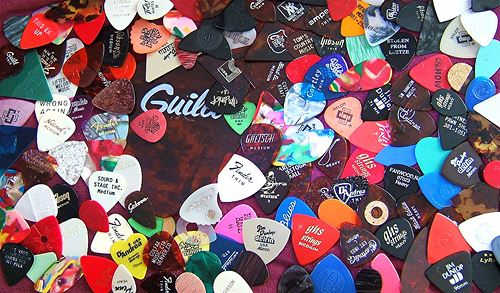by Sam Wilder
With all the money we spend on guitars, effects, amps, and more guitars it’s hard to imagine how a little piece of plastic that costs almost nothing can make such a noticeable difference in your playing. And up until right now you probably didn’t even realized it. But the truth is your pick is the bridge between you and your guitar. It’s an extension of your fingers and what’s more important than that?
When you first start playing it’s different because at that point who really cares. But after a few months or years of practice you may come to find that a simple pick change can improve or at least alter your playing literally overnight. So for today’s Pro Tip we will compare the various pick options and hopefully you’ll find one better suited to you than the one you’re using now.
The playability and tone of a particular pick basically depends on 5 factors. Thickness, hardness, texture, size/shape and material.
1. Thickness
Guitar picks come in 1 of 4 general gauges. Thin, medium, heavy and extra heavy with the actual thickness/mm of the gauges varying. Depending on the manufacturer these ranges can vary considerably. But don’t worry about the exact numbers just yet. Let’s start first by comparing thin vs thick.
Thin picks are typically better for brighter tones (because their striking surface accentuates high frequencies), tighter dynamic range (because their flexibility limits the volume that can be achieved, which works especially well for recording) and acoustic guitar strumming (partly because of the tighter dynamic range but also because it adds more clarity to the individual notes in the chord).
Thick picks are typically better for mellower tones (because the weight and rounder edges emphasize more bass and less treble), a wider dynamic range (because they offer greater control over volume and attack), electric lead guitar (because they allow for more speed and accuracy during fast solos) and heavy distorted sounds (because they offer more clarity and separation between note. And even if heavier picks happen to suit your style of play, the downside is that they require more finger strength and dexterity to control. So consider that as well when choosing your gauge.
2. Hardness
Even if a particular pick is on the thinner side, if it’s made from a HARDER material you’ll find that the added stiffness offers performance characteristics resembling that of thicker picks and vice versa. Thick but softer picks typically have performance qualities closer to that of most thinner picks. Make sense?
3. Texture
The more textured the surface of the pick the more friction will exist between the pick and your fingers and the easier it will be to grip. Especially when you’re sweaty. The same goes for softer picks. For the most part more grip is a good thing for everyone. But there MAY or MAY NOT be a trade off because texture also affects how the pick rolls off the strings. Smooth slippery picks produce cleaner, natural tone and rough picks will add more grit and color to the tone. Smooth round edges will have a warmer, more purer tone, while sharp edges will have a stronger attack and brighter sound.
4. Size and Shape
With smaller picks there’s less distance between your hands and the strings making it easier to use different hand techniques like palm muting and fingerpicking. Of course “small” is a totally relative term depending on the size of your hands. Perhaps the best advice is to find a pick big enough to fit your hands… but NO bigger.
Now, moving on to shape. You can find all kinds or weird pick shapes if you look hard enough (sharkfin picks being the most famous example) but in almost all cases you are better off sticking to a common, standard triangular teardrop shape.
5. Materials
The final and most important factor of all.
The material of the pick is what ultimately determines the stiffness, texture, and overall performance so let’s check out our options.
Throughout history, musicians have tried making picks out of almost everything imaginable and the best material of all came from the shell of the Atlantic Hawksbill Turtle and was known simply as “tortoiseshell“. Starting in the early 1900’s plastic picks designed to emulate tortoiseshell slowly gained in popularity up until the early 70’s when the Atlantic Hawksbill became endangered and plastics took over entirely. The 3 most popular plastics are nylon (which is typically softer with a textured grip, and is best suited for lightweight flexible picks), celluloid (which is stiffer with a smoother slicker texture compared to nylon) and acetal (aka Tortex, Dunlop’s popular line which has a textured grittiness that closely mimics the feel of tortoiseshell).
Now finally, what picks do I recommend? I don’t. I’m a bass player lol! No seriously, I’d love to give you a straight answer but as I’m sure you know you can only learn so much from pure information and you can’t know for sure which pick you’ll pick until you try picking with them all. Since picks are practically free anyway just buy assortment pack of different gauges and different materials. Try them out at home on your own time. That way you can take as long as you need to figure out what you like and what you don’t.
So there you go. Hopefully this post has answered all your questions and helped you find the perfect pick for whatever style music you play!

